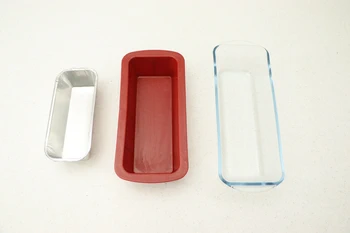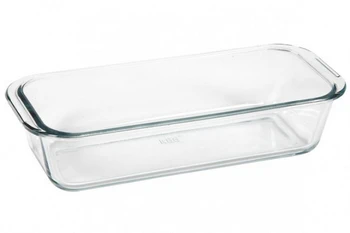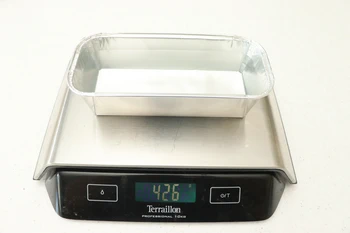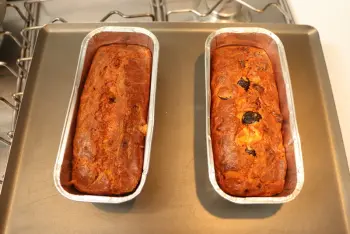Cake moulds

When we make a cake, or a cake of the same rectangular shape, we usually take out our usual mould and tell ourselves that the recipe is anyway "for a cake", but is it really that simple?
7,381 5/5 (1 reviews)
Keywords for this post:MouldsCakeMaterialSizeCapacityLast modified on: August 25th 2025
Cake moulds
There are 2 main criteria for classifying cake molds: their material, what they're made of, and their volume, or how much batter you can fit inside.
And the choice is totally up to you, as each of these materials is well suited to oven baking, after which it's more a question of personal sensitivity.
For example, I try to limit the use of non-stick molds as much as possible, so I took my old Tefal mold that I'd had for years to the scrap yard, and replaced it with a Pyrex glass mold, which is more neutral and virtually indestructible.

Of course, you'll need to be a little more careful before baking, as unmoulding could be difficult, but if you butter the mould properly before pouring in the batter, no worries.
And if the pastry is really sticky when baked, I put a strip of baking paper on the bottom, or even on the edges, and it unmolds itself.

So it's up to you, just remember that they'll all bake very well, but the tricky part will be unmolding them.
But it's not just the big ones: you'll also find small molds that are often twice as small, and therefore have a capacity of 600 ml, which is handy if you want to make 2 small cakes rather than one big one.
The mold needs to be able to hold the volume of batter, but not be completely full afterwards, as the cake will almost certainly swell and rise during baking, so the edges of the mold need to be high enough to prevent it from overflowing.
This varies quite a bit from brand to brand, but you can easily check it by calculating the volume of your mold by multiplying its length x width x height in millimeters, and you'll get its volume in milliliters.
 .
.


They're practical, easy to use and, above all, they can be reused several times. Contrary to their name, it would be a real shame to throw them away when they can be washed and reused.
To sum up: whatever material you choose for your mold, baking will go smoothly, the only tricky part is unmolding, and for certain materials (glass and raw metal) you need to take care to butter the mold well, or even protect it with a sheet of baking paper.
The material
The choice is yours, to say the least: steel, silicone, glass, non-stick steel, exoglass, aluminum...And the choice is totally up to you, as each of these materials is well suited to oven baking, after which it's more a question of personal sensitivity.
For example, I try to limit the use of non-stick molds as much as possible, so I took my old Tefal mold that I'd had for years to the scrap yard, and replaced it with a Pyrex glass mold, which is more neutral and virtually indestructible.

Of course, you'll need to be a little more careful before baking, as unmoulding could be difficult, but if you butter the mould properly before pouring in the batter, no worries.
And if the pastry is really sticky when baked, I put a strip of baking paper on the bottom, or even on the edges, and it unmolds itself.

So it's up to you, just remember that they'll all bake very well, but the tricky part will be unmolding them.
Capacity
All "classic" cake molds have a capacity that allows them to hold a volume of batter of around 1000 ml (1 liter of batter), which is the standard capacity.But it's not just the big ones: you'll also find small molds that are often twice as small, and therefore have a capacity of 600 ml, which is handy if you want to make 2 small cakes rather than one big one.
The mold needs to be able to hold the volume of batter, but not be completely full afterwards, as the cake will almost certainly swell and rise during baking, so the edges of the mold need to be high enough to prevent it from overflowing.
This varies quite a bit from brand to brand, but you can easily check it by calculating the volume of your mold by multiplying its length x width x height in millimeters, and you'll get its volume in milliliters.

Another, quicker solution is to place your mold on a scale, tare it and fill it with water. The weight indicated will be its capacity (or volume).
Once you have the capacity of the mold, divide the value by 3 and you'll have a good estimate of the weight of batter you can pour into it.
Disposable moulds
Aluminum disposable molds of various sizes (mainly 1200 or 600) are now readily available, and are widely used by professionals.

They're practical, easy to use and, above all, they can be reused several times. Contrary to their name, it would be a real shame to throw them away when they can be washed and reused.
To sum up: whatever material you choose for your mold, baking will go smoothly, the only tricky part is unmolding, and for certain materials (glass and raw metal) you need to take care to butter the mold well, or even protect it with a sheet of baking paper.
Lasts posts
Butter vs. grease
We often read in a recipe where a pastry is put into a mould that, just before pouring, the mould should be buttered or greased. But what's the difference between these 2 terms?December 1st 20251,4005
Getting out of the fridge early
Very often when you're cooking, you need to take food or preparations out of the fridge, to use them in the recipe in progress. There's nothing tricky about this: you just take them out of the fridge and use them, usually immediately, in the recipe. But is this really a good method?November 24th 20251,2685
Who's making the croissants?
When you look at a bakery from the outside, you naturally think that in the bakery, the bakers make the bread, and in the laboratory, the pastry chefs make the cakes. It's very often like that, with each of these professions having quite different ways of working, but sometimes there's also one...November 23th 20251,158
Oven height
When we put a dish or cake in the oven, we naturally tend to put it on the middle shelf, and that's what we usually do. But in some cases, this position and height can be a little tricky, so let's find out why.October 8th 20253,2375
The importance of sieving
In recipes that use a fine powder (flour, powdered sugar, etc.), you'll often see the advice to sift before using it. To sift is to pass the powder in question through a sieve (a very fine strainer) before incorporating it into your recipe. It's often advice, but is it really useful?September 3rd 20257,8743
Other pages you may also like
Butter vs. grease
We often read in a recipe where a pastry is put into a mould that, just before pouring, the mould should be buttered or greased. But what's the difference between these 2 terms?December 1st 20251,4005
Making the most of seeds: Dry roasting
In cooking, and particularly in baking, there are a lot of seeds we can use, such as linseed, sesame, poppy, etc. Usually, recipes simply say to add them just as they are to the mixture or dough. To make a seeded loaf, for example, prepare a plain bread dough as usual, then, towards the end of...January 30th 201562 K4.0
Steam for baking bread
What does steam have to do with bread-making? This is not only a bakers' secret, it is something you might not think of at all: if you make bread and bake it like a cake, you will end up with bread, but pale and with a thick, hard crust – a long way from the golden-brown crusty loaf you had in...June 16th 2021147 K4.5
The importance of sieving
In recipes that use a fine powder (flour, powdered sugar, etc.), you'll often see the advice to sift before using it. To sift is to pass the powder in question through a sieve (a very fine strainer) before incorporating it into your recipe. It's often advice, but is it really useful?September 3rd 20257,8743
Oven height
When we put a dish or cake in the oven, we naturally tend to put it on the middle shelf, and that's what we usually do. But in some cases, this position and height can be a little tricky, so let's find out why.October 8th 20253,2375
Post a comment or question
Follow this page
If you are interested in this page, you can "follow" it, by entering your email address here. You will then receive a notification immediately each time the page is modified or a new comment is added. Please note that you will need to confirm this following.
Note: We'll never share your e-mail address with anyone else.
Alternatively: you can subscribe to the mailing list of cooling-ez.com , you will receive a e-mail for each new recipe published on the site.






